How To Stand Up Paddle Board
LEARN HOW TO STAND UP PADDLE BOARD WITH THESE HELPFULL TIPS!
While the are of stand up paddle board is one of the earliest and most ancient forms of surfing, over the past three years it has become one of the fastest growing watersports and one of the most popular ways for people to enjoy the ocean. Due to its user-friendly nature, stand up paddle boarding has become popular with people of all ages and allowed even the most uncoordinated and unbalanced a chance to enjoy the water.
Here are some basic techniques to help you make the most of your Stand Up Paddling adventure in Kona, Hawaii.
Ideal Conditions
Stand up paddle boarding can be done in just about any ocean condition but the best conditions for beginners are smooth seas with little to no chop on the surface which will allow you to maintain your balance easier. Kahaluu Bay in Kona, Hawaii is a perfect place for stand up paddling, wheather you are a beginner or a seasoned vet.
Wiping Out
To decrease the likelihood of injury when wiping out, always fall away from your board and land on your side or butt. The paddles are made to float so when you start to go down, toss your paddle away from you so you don’t land on it. Once you have wiped out, swim back to your paddle board, get into the prone position and then swim over and retrieve your paddle.
Paddling Positions
Prone Position– When learning how to Stand up Paddle it is important to practice in an area that is not close to the shoreline and shallow water. Get into the prone position by laying down on your belly with the paddle under your chest, and paddle using your arms to an area where you can safely practice.
Knee Position– Once you are in a safe area, it’s time to find the sweet spot on the paddle board. This is area in the center of the board where you will have the most balance. Most paddle boards have a handle in the center of the board for easy carrying which also serves as a marker for the sweet spot on the paddle board. Slide to your knees and sit back on your feet. The paddle board should lay flat on the water. When paddling on your knees, hold the paddle with both hands close to the blade or scoop part of the paddle. The knee position is an easy way to practice your paddling techniques before you get to your feet.
Stand Up Position– Like the knee position, finding the sweet spot on the paddle board will increase your balance. Place your paddle across the paddle board in front of you and slowly plant one foot at a time on the board. Your feet should be side by side and about shoulder width apart for maximum balance. Once you have made it to your feet, bend your knees, keep your back straight and stay low over your board.
How to hold the Paddle
Proper paddling techniques will help you learn how to stand up paddle more effectively, safely and comfortably. The most common mistake people make when learning how to stand up paddle is holding the paddle the wrong way. The blade or scoop of the paddle should be facing up in order to displace the most water and give you the strongest paddle stroke with the least amount of effort. When knee paddling, hold the paddle near the base of the blade with your hands about shoulder width apart. When stand up paddling, one hand should be at the top of the paddle and the other hand toward the middle of the paddle. When switching sides, you should alternate your hands as well.
Maneuvering your Stand up Paddle Board
Going Straight– To paddle straight, use long and powerful strokes, alternating sides as needed. To get the most power from your stroke, make sure that the blade is fully in the water. This will also help with stability since the blade acts as a brace to help keep you stable when in the water. Another technique for a more powerful stroke is to keep your arms straight and use a down and back stroking motion. Use your arms, legs and core muscles to help pull your paddle board through the water.
Turning– There are several different methods for turning your paddle board left and right. The first is the “Wide” paddle, which is done by making a big arcing stroke either on your right or left and side. Wide paddling on the right will turn you to the left and wide paddling on the left will turn you right.
The second turning method is called the “Back” paddle. To back paddle, flip the blade of the paddle upside down and place it in the water near the tail of your board and push forward. Unlike the wide paddle, back paddling on the left and side will turn you to the left and back paddling on the right will turn you to the right. The back paddle also offers a sharper more pivoting style turn than the wide paddle which like the name say’s, creates a very wide turn.
It may take some practice, but mastering these stand up paddle board techniques will help you become a more efficient paddle boarder.
Stop by our location located at Kahaluu Bay in Kona, Hawaii and sign up for a Stand Up Paddle Lesson with one of our expert instructors. Already know how to stand up paddle board, then come check out our huge selection of highl quality stand up paddle board rentals and surf the long rolling waves at Kahaluu Bay.
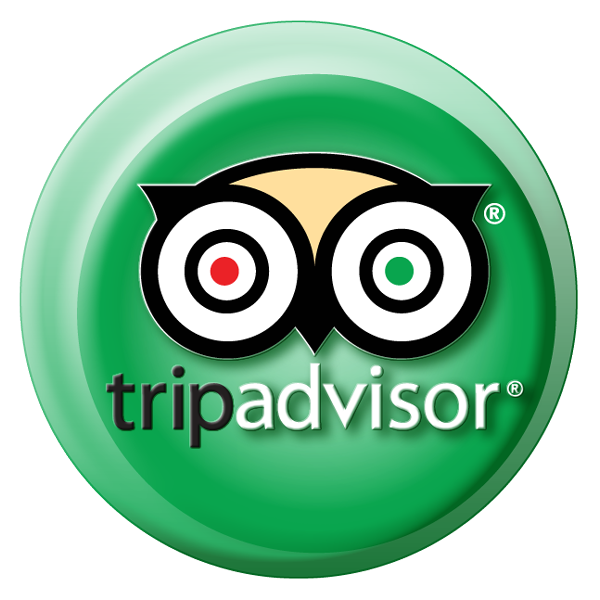



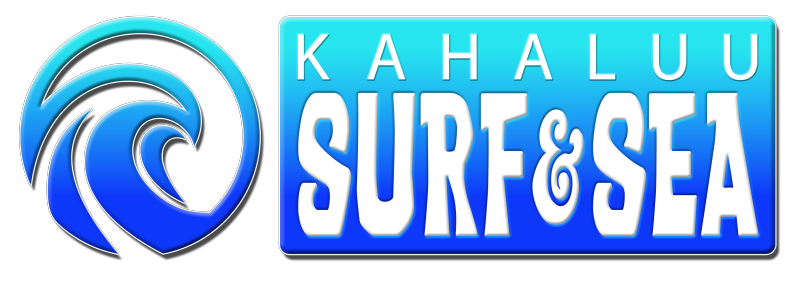

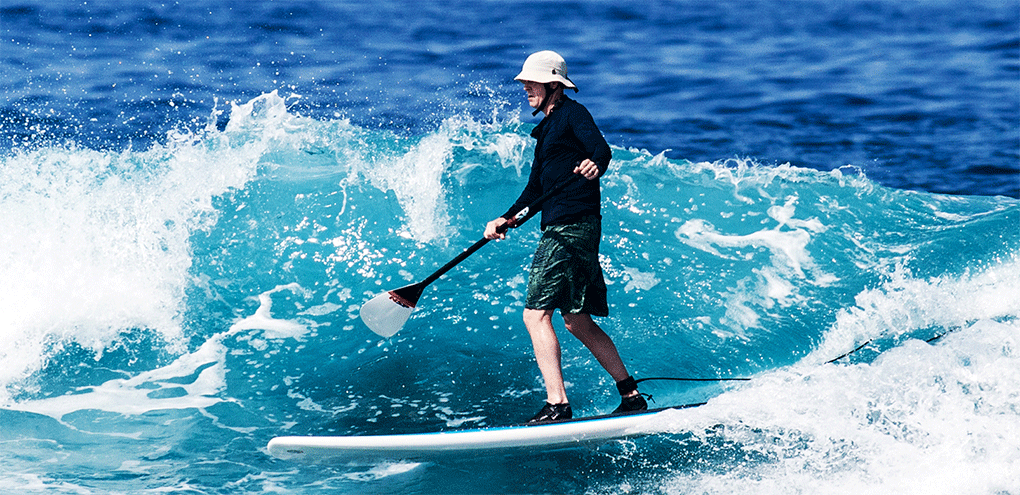
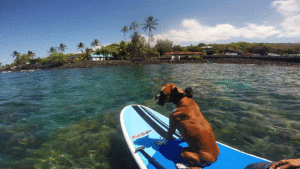
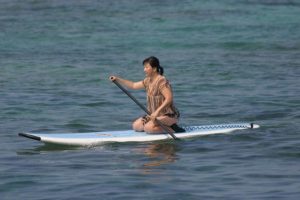
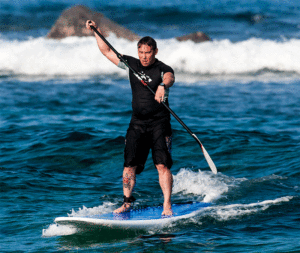
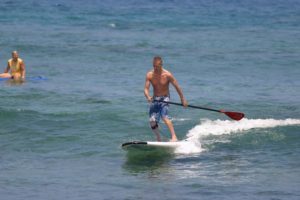
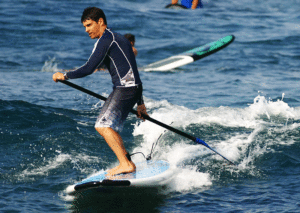
Ben
Great SUP information. I have a 10 ft starboard whopper SUP . Any suggestions on how to transition for righ t to left turn. Maybe need to come by for a lesson. Not sure I would toss my. 200 dollar paddle on a wipe out. I may hold on and hope fore the best. Great article.
Gulf Coast Surfer
D. Green
Aloha David,
You can turn quicker by using a combination of back and wide paddling techniques. For example, to turn left faster, back paddle once on the left and then to a wide paddle on the right. This should help you spin around faster which is helpful when you are tring to catch waves. Thanks for the response. Hope you get some good surf this winter. Send us some pictures from Terries Cove and the Point.
Tired the turn in about 2 ft surf. Worked really well. Thinking about getting a 3,2 wetsuit for cold water. What about a psycho 111. What do you need inHawaii? Maybe a vest or just lycra sun shirt?
Great post! This information is really useful. I’ve always wanted to try out Paddle boarding but was never very confident on how to start and how to actually manoeuvre the board. I also didn’t want to look silly, this post has defiantly cleared up the basic techniques to successfully paddle board. I know it will be harder than it looks, I’ve tried surfing a couple of times, and the technique and your overall fitness really plays a big part in staying on the wave or crashing! It’s actually also quite a workout!
Its been raining for the last week and half here in Perth, Australia (which is very rare, but we need it) so when the weather clears up, I am looking forward to taking a break from uni and applying the techniques in this post. Wonderful advice and thanks for sharing!
Haleh, Perth, Western Australia
Do the inflatable paddle boards like those at http://www.paddleboardstop.com work the same?